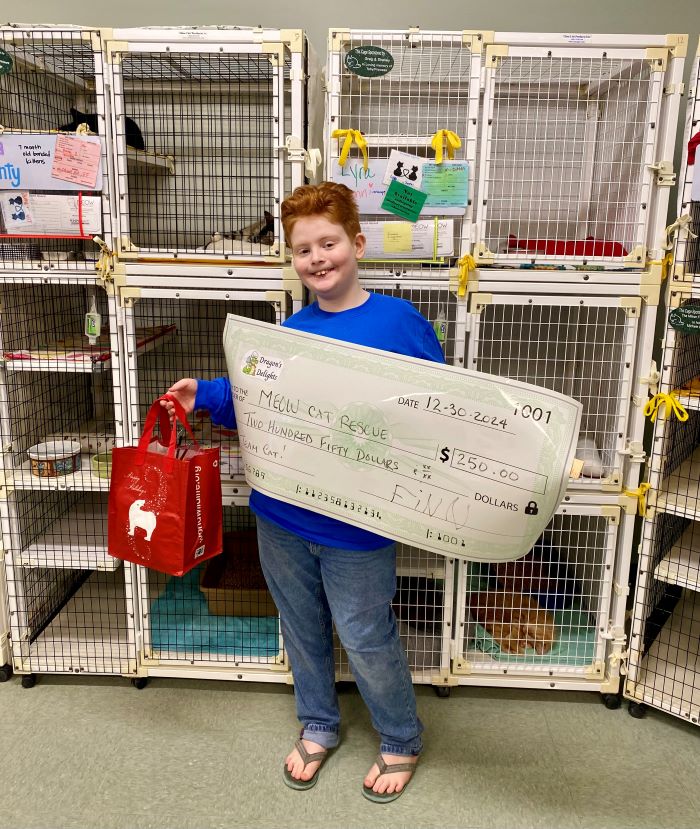MEOW has limited opportunities to volunteer for those under age 18, so unfortunately we are unable to provide teens with opportunities which satisfy school service requirements. However, we encourage teens to help promote animal welfare with the suggestions below.
Featured Story

Finn may be just 9 years old, but he has a heart of gold when it comes to giving. When he was just 5 years old, he learned about a child in his neighborhood with cancer and he wondered what he, as a kid himself, could do to help. Thus began his over 2-year commitment to grow out his hair to donate to Wigs for Kids, not once but twice, donating over 14 inches each time!
Shortly after that initial hair donation, Finn saw some other kids in his neighborhood with a lemonade stand hoping to make some spending money for themselves and he thought, that’s nice, but I can do better than that! He decided he could hold a neighborhood bake sale and donate any money he made to a charity of his choice.
He had started cooking early in life; helping his mom make his first loaf of bread when he only 18 months old. On his 4th birthday he was then gifted a monthly children’s cooking box subscription, Raddish Kids, and he was hooked!
In the Classroom
- Prepare a report or speech for your class about an animal welfare issue and/or about responsible pet care.
- Ask your teacher if the class can start a letter-writing project. Talk to animal welfare organizations about why most animals are being turned over to shelters. Write letters to your local and state government officials and to newspapers to raise awareness of these factors. Make a bulletin board in a high traffic area of your school to draw other students’ attention to these issues.
- Volunteer to help younger students with reading and focus on stories that advocate helping animals and treating them with respect and kindness.
You might also want to look into having a school-wide animal welfare related assembly, or you could request school field trips to animal shelters or sanctuaries. If a large number of students show interest in and are commitment to helping organize such events, school officials should at least be willing to hear you out.
Start a petition, draw up a proposal (including suggestions as to how the event might work and reasons why it is of importance to students), and present it to those in charge of setting up assemblies and/or field trips. Get student government and extra-curricular service groups involved.




In Your Community
Get in touch (and stay in touch) with your local animal shelter. Shelters are often in need of supplies and more often in need of additional funding. Offer to hold a blanket or food drive or to organize a fundraiser. Have a bake sale, set up a booth at a community-wide festival, put together a miniature golf or bowling tournament, or host a block party aimed at gathering donations.
Be creative and make the fundraising process fun for all involved; the results will amaze you. And the money collected can be used to sponsor spay/neuter programs or to meet some of the needs of your local animal shelter. That said, if you host such an event, you should be sure to share your successes by letting those who contributed know just what their money and efforts have made possible.




More Ideas
- If you know an elderly person or someone with an illness who may need help caring for their pet, volunteer your services. By helping to feed, walk, groom, and pick up after their dog or cat, you may enable them to keep a pet they might otherwise have to send to a shelter.
- Create a bulletin board for your grocery store, school, library, or other popular area with pictures of MEOW’s adoptable animals and contact information for MEOW. Be prepared to maintain the bulletin board by updating it frequently.
- Make fliers and/or posters about the importance of spaying and neutering, adopting rather than purchasing pets, or other important animal welfare issues and about how to help stop the killing of healthy, adoptable animals in our nation’s shelters. Ask to post them in neighborhood stores, in vets’ offices, and/or on community bulletin boards.




In Your Home
- Get your family involved in your volunteer activities.
- Talk to your family about signing up to be a foster home for MEOW.
- Invite your relatives to visit MEOW and encourage them to lend a hand with the daily tasks involved in keeping it running by signing up to be a volunteer.
- Ask them to help you with some of the classroom or community activities listed above. Through working together and spreading the word as a family, you can accomplish a lot.

